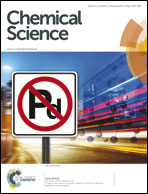Fluorinated amino acids in amyloid formation: a symphony of size, hydrophobicity and α-helix propensity†
Abstract
Fluorinated amino acids can have dramatic effects on protein stability and protein–protein interactions due to the unique stereoelectronic properties of fluorine. Previous approaches to assessing their properties have mainly focused on helical systems, even though fluoro-amino acids are known to exhibit lower intrinsic helix propensities than their hydrocarbon analogues. Fluorination of specific β-sheet positions within globular proteins has been shown to have a stabilizing effect, suggesting that fluorinated amino acids may generally be well suitable for modulating non-helical structures. Still, fluorinated amino acids have rarely been studied in amyloid forming peptides, which take on a characteristically high cross-β-sheet content. Here, we examine the substitution of natural amino acids within an amyloid forming model peptide by amino acids that contain different stoichiometries of fluorine in their side chains. This approach enables a systematic evaluation of the impact of fluorine on amyloid formation. We have investigated the impact of size, hydrophobicity and secondary structure propensities of the fluorinated amino acids on the amyloid formation process. The structure of the model peptide is based on an engineered coiled coil folding motif that was designed to provide an α-helical starting structure that can fold into β-sheet rich amyloids under controlled conditions. Substitution with fluorinated amino acids was accomplished for two neighboring valine residues that play a key role in the structural transition. The resulting peptides show an unexpected folding behavior as a consequence of the interplay of stereoelectronic effects, helix propensity, hydrophobicity and position of the particular substitution within the amyloid forming system.


 Please wait while we load your content...
Please wait while we load your content...